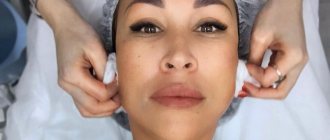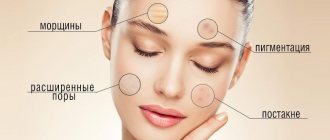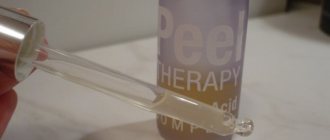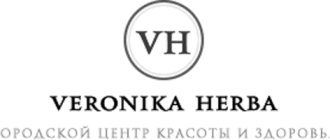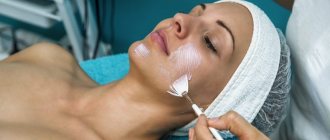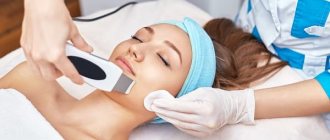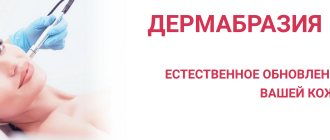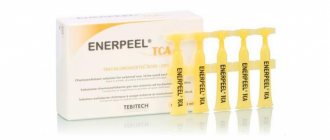The face is the calling card of every girl, so in this area you need to take special care of the skin. There it is very delicate and requires various procedures. Currently, there is a poor environmental situation, an accelerated pace of life, constant overload - all this does not have the best effect on the condition of the skin of the face, activating prematurely the aging process.
Modern cosmetology adapts to the needs of the fair sex. More and more new procedures are appearing that provide maximum effect in maintaining the beauty and health of the skin. One of them is diamond peeling.
Features of the procedure
Diamond peeling refers to facial cleansing - during the procedure, dead areas of the epidermis and impurities are removed. For this purpose, specialized equipment is used, namely, diamond-coated nozzles.
The procedure is carried out in comfortable conditions, so you will not suffer any unpleasant or painful sensations. Also, this type of peeling does not require long-term recovery. It is enough to follow a number of simple recommendations.
But, unfortunately, the procedure also has contraindications, so you must first consult with specialists.
Diamond facial cleansing is also called resurfacing, as it makes the skin perfectly smooth, removing all imperfections.
Diamond dust – small diamond crystals processed by a laser – is applied to special attachments.
Differences between microdermabrasion and dermabrasion -
Microdermabrasion and dermabrasion are cosmetological methods that are based on mechanical grinding of the skin using abrasive elements. These methods differ only in the depth of skin resurfacing. Microdermabrasion involves removing only the most superficial layer of skin, consisting of dead epidermal cells.
But with dermabrasion, the depth of resurfacing is much greater, which implies subsequent more significant changes in the skin. The dermabrasion method is more radical, requires more qualified doctor and should, as a rule, be performed only by dermatologists or plastic surgeons.
Microdermabrasion: indications
Because This procedure does not cause any noticeable damage to the skin - it is completely safe for most people. Although the face is the most common area for microdermabrasion, this method can be used on absolutely any area of the skin: neck, chest, back, and arms. The skin can become noticeably smoother even after one treatment, and it begins to better absorb moisturizers (creams, oils).
Microdermabrasion is generally recommended for people over 12 years of age and for adults under 65 years of age. Age restrictions are conditional, because People over 65 have a higher risk of bruising and skin abrasions, and people under 12 can receive treatment under the supervision of a dermatologist.
Indications are –
- photoaging of the skin as a result of exposure to sunlight,
- reducing the depth of fine wrinkles,
- age spots,
- in complex therapy of acne (acne),
- if you have superficial acne scars,
- the need to improve complexion (especially for people with yellowish skin).
For acne - dermatologists quite often use microdermabrasion for acne to help clean out deep pores and improve skin condition. Moreover, when treating acne, dermatologists usually use microdermabrasion in combination with superficial chemical peels based on glycolic or acetyl salicylic acids. This combination significantly speeds up recovery (Fig. 9-11).
For melasma - yes, microdermabrasion can be useful in the treatment of melasma and other types of hyperpigmentation (24stoma.ru). Optimal treatment in such situations would include microdermabrasion (every 2-4 weeks) combined with glycolic acid peels (once weekly). The general course of treatment is 6 weeks. In addition, the use of lightening creams (such as hydroquinone 4%) is recommended, as is the daily use of sunscreen.
Microdermabrasion: Before and After photos
Peeling effectiveness
This type of peeling is highly effective. It is used for the following purposes:
1. removal of scars left after acne treatment;
2. fight against fine wrinkles, stretch marks;
3. removal of freckles, age spots;
4. smoothing the skin surface;
5. return of the skin to its natural color;
6. cleansing clogged pores.
Diamond vacuum facial cleansing is recognized as the most comfortable cosmetic procedure, since it is not only painless, but also hypoallergenic.
Results of diamond microdebrasing
This peeling not only removes dead skin cells from its surface, but also stimulates the production of collagen by the skin, which is the key to increasing its firmness, elasticity, and tone. The relief and tone of the skin are evened out, peeling can remove or smooth out scars, scars, post-acne, and shallow wrinkles from the surface of the skin.
The color quality of the skin improves, it acquires an even tone, becomes young and radiant. Thanks to this peeling, age spots, freckles, and areas of hyperpigmentation will be eliminated from the facial skin. Enlarged pores on the face become less noticeable. The skin acquires tone, the elasticity of the skin increases, it literally looks younger.
Colady illustration
Colady illustration
Sequence of the cleaning process
The procedure is performed in several stages:
1. skin preparation;
First you need to prepare the surface of the skin for cleaning. For this purpose, it is steamed, and then a special moisturizer is applied to it to achieve maximum peeling effect.
2. performing cleaning;
When all preparatory procedures have been completed, you can proceed directly to cleaning. The surface of the skin is treated using diamond-coated attachments, and there should be several of these attachments in order to treat the entire surface of the facial skin with maximum effect. During the peeling process, the cosmetologist changes the attachments several times.
Facial cleansing unclogs skin pores, eliminates flaking and promotes rejuvenation, which is why diamond peeling has recently become increasingly popular.
3. treating the skin with nutrients.
The final stage of the procedure is applying a nourishing mask to the skin. After peeling, the skin becomes more receptive, so with the help of specialized products it is saturated with necessary microelements that activate protective mechanisms.
The total duration of the peeling procedure is about 40 minutes.
How is facial microdermabrasion performed in a beauty salon?
If you want to get a guaranteed effect after a course of treatment, you must follow the recommendations of specialists. The procedure consists of several steps.
- Preparation. At this stage, it is recommended to use specific products that help soften the outer layer of the skin and make cleaning easier.
- Cleansing. Removing makeup residues using special products that prepare for the procedure.
- Grinding with microcrystals or diamond nozzles. Depending on the type and thickness of the skin, the session lasts from 20 to 40 minutes.
- Application of skin softening and soothing agents that accelerate regeneration and relieve inflammation.
The duration and number of microdermabrasion sessions depend on the specifics of the patient’s skin, as well as on the specific defects that need to be eliminated. To eliminate minor deficiencies, 5-8 procedures are enough. In any case, you should trust only professionals, whose skill and experience will allow you to carry out the necessary grinding procedure efficiently. Residents of Moscow can find such highly qualified specialists in the city.
Read material on the topic: Ozone therapy: methods, effect, reviews, photos
Skin care after the procedure
After peeling for several days, the skin requires special care. The following recommendations should be taken into account:
1. It is necessary to regularly use moisturizing cosmetics (selected together with an experienced specialist).
2. You cannot stay in direct sunlight, strong wind or frost for a long time.
3. Sunscreen must be used.
4. For 1-1.5 weeks, visiting baths, saunas and fitness clubs is not recommended.
5. For a period of 1-1.5 weeks you need to give up decorative cosmetics and foundation.
Diamond facial peeling usually takes place without any consequences, but in some cases, redness of the skin may occur for a couple of days.
Indications for diamond peeling
- Enlarged pores on the skin.
- Pigmentation, age spots, freckles.
- Wrinkles, sagging facial skin.
- Dull, tired, lifeless skin.
- The presence of post-acne, scars, wrinkles, scars, comedones on the skin.
- Cellulite (body peeling).
- Acne, clogged pores.
- Ingrown hair on the face and body.
- Oily skin prone to acne formation and clogged pores.
- Stretch marks on the skin of the body.
- Very uneven, bumpy surface of the skin.
- Rapid aging of the skin, lack of elasticity.
Contraindications to the procedure
Despite all the convenience of this cosmetic procedure, as well as its hypoallergenicity, there are a number of contraindications to this type of peeling. These include:
1. any skin diseases (dermatitis, herpes, eczema, etc.);
2. presence of damage to the skin (abrasions, wounds, burns);
3. increased pigmentation of the skin;
4. presence of autoimmune or inflammatory diseases;
5. diabetes mellitus;
6. pregnancy and lactation.
Before undergoing a diamond peeling procedure, it is imperative to consult with a specialist.
Peeling: chemistry, apparatus or mechanics?
Chemical exfoliation is essentially a dosed burn of the epidermis with inevitable redness of the skin. Preparations based on active acids and alkalis eat away dead skin cells, causing the skin to renew itself.
Hardware peeling is considered the most gentle way to exfoliate “dead” skin. Ultrasound treatment of mature skin tones the skin and gives it a fresh look, but it cannot rid a woman of age wrinkles and age spots.
Diamond peeling is considered an effective method of mechanical exfoliation. The smallest abrasive particles destroy the epidermal scales of the upper stratum corneum, as a result of which the skin texture is evened out and the facial contour is tightened.
Where to contact
Due to the fact that diamond facial cleansing is gaining popularity, the procedure is offered by an increasing number of specialists. Some even offer in-home services, but you should not contact them.
The procedure must be carried out by experienced specialists using professional equipment.
Therefore, it is better to go to a beauty salon, where a cosmetologist will identify your problems, help solve them and give recommendations for further skin care.
Side effects
When performing diamond-vacuum peeling, you need to be prepared for side effects. They may be as follows:
• Microcracks. They appear when a specialist has chosen the wrong nozzle with high abrasiveness;
• Skin inflammation. Very rare. Masks and special serums will help;
• The appearance of age spots. Appear due to the fact that a woman after the procedure spends a long time in the sun or visits a solarium;
• Facial swelling. Goes away on its own within 1-2 days.
Almost all side effects can be avoided. To do this, you need to choose a qualified specialist and follow all his recommendations for facial care after the procedure.
Chemical peeling: types, results and possible consequences
Since dry cleansing is the most common method of skin rejuvenation, let us dwell in more detail on the features, advantages and disadvantages of this procedure. Depending on the type of drug used, chemical peels of superficial, medium and deep effect are distinguished.
- Superficial peeling is painless and safe, however, the effect of this procedure is less pronounced. When using low pH acids (glycolic, lactic, citric, tartaric, malic), skin exfoliation occurs in the stratum corneum.
- Medium peeling is a gentle exfoliation method. Exposure to high pH chemicals (20% salicylic acid, 25% trichloroacetic acid, retinoids, azelaic acid) occurs down to the basement membrane. After this procedure, skin elasticity increases, oiliness disappears, and pores narrow.
- Deep peeling using phenol and 35% trichloroacetic acid penetrates to the papillary dermis. In this case, a median peel is performed in the paraorbital (around the eyes) and oral (around the mouth) zones.
Superficial exfoliation of the skin can be done at home.
Medium peeling and phenol skin peeling procedures are carried out only by a cosmetologist. Any type of chemical exfoliation requires a rehabilitation period; with deep cleaning (it can be done only once and under anesthesia), the recovery period can last up to three months.
- The toxicity of chemicals can cause arrhythmia, heart or kidney failure, so the presence of a resuscitation team is required during the procedure.
- Chemical procedures can cause allergies, hyperpigmentation or depigmentation, as well as provoke inflammatory and infectious skin diseases.
- If the procedures are carried out incorrectly, scarring and the appearance of a demarcation line may occur.
Indications and contraindications
Microdermabrasion sessions are best performed after 25 years. It is at this age that women experience the first signs of skin aging.
Indications for use of diamond facial cleansing:
- Elimination of minor stretch marks and defective surface changes (scars, scars).
- Signs of irritation, acne, increased greasiness of the epidermis.
- Oily or dry skin.
- Freckles, acne, pigmentation, ingrown facial hair.
- Age-related changes – flabbiness and fading.
Cleaning problem areas is done to reduce severe greasiness, cleanse pores, smooth the surface and remove impurities. In case of increased dryness of the epidermis, the procedure is preparatory in nature - the session is used as an auxiliary session before the main manipulations to normalize hydration and nutrition.
The diamond cutting process does not treat excess skin pigmentation. However, the procedure can accelerate the spontaneous disappearance of natural defects by renewing the upper layers of the epidermis.
Contraindications are:
- Fresh wounds, abrasions or inflammatory lesions.
- Fungal infections.
- Cuperosis.
- Sunburn of the surface.
- Hyperkeratosis.
- Active stage infectious or viral disease.
- Pregnancy and breastfeeding.
- Diabetes mellitus of any degree.
- Active manifestations of allergies.
- The period of menstruation and the first time after it.
- Bronchial asthma.
- History of epilepsy.
- Oncological and cardiovascular pathologies.
Some contraindications are temporary. A diamond session can be performed after eliminating these deficiencies and a complete cosmetic examination of the skin.
For patients over 40 years of age, there are restrictions on the use of this type of peeling. For example, due to age-related changes, frequent sessions are contraindicated due to the risk of developing infectious inflammation. At this age, the skin needs more significant cleansing, since microdermabrasion does not affect the deeper layers of the epidermis.
Benefits of Microdermabrasion
Unlike other peelings, microdermabrasion has a number of undeniable advantages:
- No pain. The cosmetic procedure does not require the use of anesthetics, since it does not cause pain.
- Diamond peeling is less traumatic and can even be used to polish ultra-sensitive facial skin.
- Mechanical peeling removes more than 80% of dead cells from the top layer of the epidermis.
Due to the removal of dead cells, dark spots, freckles, expression lines, acne, and acne from the face and neck disappear after the procedure.
Possible complications
The effectiveness of the cleaning largely depends on the professionalism of the cosmetologist. For example, excessive pressure on the skin or the wrong choice of nozzle provokes the occurrence of spider veins, small abrasions and hyperemia.
When the patient takes vasodilators, inflammatory complications may develop during diamond resurfacing - hyperpigmentation, bruising, herpes rashes. In these cases, it is more advisable to wait until the end of the course of conservative therapy.
Algorithm for selecting a brightening peeling
What to look for when choosing a peel:
- Depth of pigmentation
Epidermal type - superficial and superficial-medium peels that do not affect the deep layers of the skin;
Dermal and mixed type - medium peelings - deep layers of skin.
- Peeling composition
According to the Latin American Pigmentary Disorders Academy, it is recommended: for mild pigmentation (very initial) - monotherapy (1 lightening substance);
In the case of moderate and moderately severe, chronic pigmentation - combination therapy (lightening substances from different groups, working on different links in the pigment formation chain).

